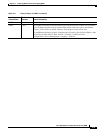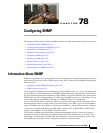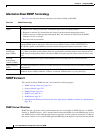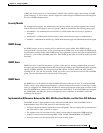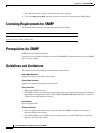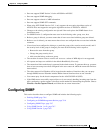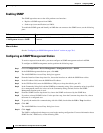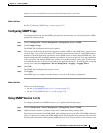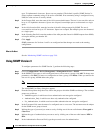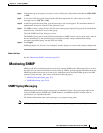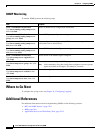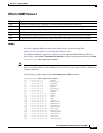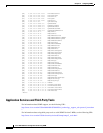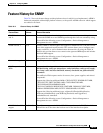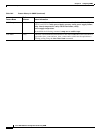
78-7
Cisco ASA 5500 Series Configuration Guide using ASDM
Chapter 78 Configuring SNMP
Configuring SNMP
http://www.cisco.com/en/US/docs/security/asa/asa82/snmp/snmpv3_tools.html
What to Do Next
See the “Configuring SNMP Traps” section on page 78-7.
Configuring SNMP Traps
To designate which traps that the SNMP agent generates and how they are collected and sent to NMSs,
perform the following steps:
Step 1 Choose Configuration > Device Management > Management Access > SNMP.
Step 2 Click Configure Traps.
The SNMP Trap Configuration dialog box appears.
Step 3 The traps are divided into the following categories: standard, IKEv2, entity MIB, IPsec, remote access,
resource, NAT, syslog, CPU utilization, CPU utilization and monitoring interval, and SNMP interface
threshold. Check the applicable check boxes for the SNMP events to notify through SNMP traps. The
default configuration has all SNMP standard traps enabled. If you do not specify a trap type, the default
is the syslog trap. The default SNMP traps continue to be enabled with the syslog trap. All other traps
are disabled by default. To disable a trap, uncheck the applicable check box. To configure the syslog trap
severity level, choose Configuration > Device Management > Logging > Logging Filters.
Step 4 Click OK.
The SNMP Trap Configuration dialog box closes.
Step 5 Click Apply.
The SNMP traps are configured and the changes are saved to the running configuration.
What to Do Next
Choose one of the following:
• See the “Using SNMP Version 1 or 2c” section on page 78-7.
• See the “Using SNMP Version 3” section on page 78-8.
Using SNMP Version 1 or 2c
To configure parameters for SNMP Version 1 or 2c, perform the following steps:
Step 1 Choose Configuration > Device Management > Management Access > SNMP.
Step 2 (Optional) Enter a default community string in the Community String (default) field.
Enter the password used by the SNMP NMSs when sending requests to the ASA. The SNMP community
string is a shared secret among the SNMP NMSs and the network nodes being managed. The ASA uses
the password to determine if the incoming SNMP request is valid. The password is a case-sensitive value



